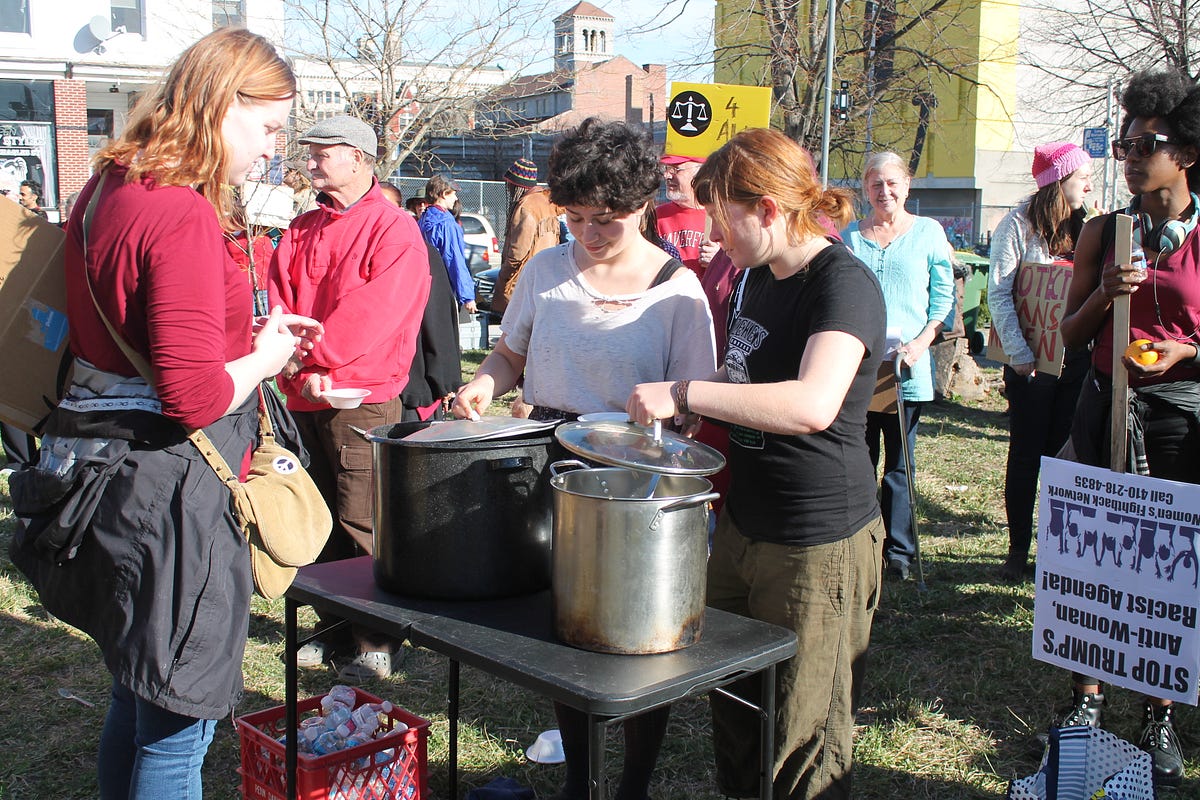By Patrick Young
Shared social movement infrastructure in popular uprisings
Across the United States and around the world, the past decade has been marked by a series of dramatic episodes of social movement uprisings. Thousands of people have taken to the streets facing down chemical weapons and police violence, camped out for months at a time blocking the expansion fossil fuel infrastructure, and faced felony charges and decades of jail time for their alleged participation in militant direct action.
Images of protestors facing down tear gas, people locked to construction equipment, and burning limousines have appeared on the front pages of newspapers around the country and been plastered across social media. But every mobilization, every blockade, every march has depended on a complex network of movement infrastructure that will likely never make it to the front page of the papers. To make all of these things possible, hundreds of people prepared and served food, organized legal support, set up medical clinics, designed websites, facilitated trainings, organized transportation, secured meeting spaces, maintained databases, and took on dozens of logistical tasks that allowed movements to operate.
Many of the social movements that have emerged in recent years have moved beyond simply critiquing the systems they were struggling against, they also offered new models of how society could be organizing. Throughout these long and challenging mobilizations, thousands of people experimented with modeling and developing the practices of direct democracy, autonomy, and mutual aid that their movements aspired to create.
Much has been written on the manifestations of direct democracy in the political sphere that were on display at the mass assemblies of the Occupy Movement and other plaza mobilizations around the world.[1] Something less explored and certainly less celebrated are the practices of mutual aid and solidarity that have been baked into the economic and social, as well as the political spheres of these new social movements. In the plaza movements and the more recent episodes of contention in Ferguson, Standing Rock and J20 social movement infrastructures emerged to provide the food, medical care, legal support, internal communication, transportation and myriad other logistical needs of the movements. Developing all of these aspects of social movement infrastructure offered participants opportunities to create and practice models of direct democracy and mutual aid in allocating scarce resources, navigating social relationships, and providing the basic human necessities that participants needed to continue to engage in the movements.
 While much of this social movement infrastructure emerges organically within distinct social movements or mobilizations, many of the networks, organizations, and institutions with the skills, resources, and experience in providing social movement infrastructure frequently mobilize across seemingly disparate social movements spaces at different times and in different places. From the outside, the episodes of contentious politics that played out in Ferguson, Standing Rock and J20 appear as distinct social movements with little overlap. But interestingly, many of the same organizations and networks providing food, legal support, and medical care participated in each of these uprisings. The people doing this important work each had unique backgrounds and movement histories but over a lifetimes of activism, their paths have continually crossed in the streets.
While much of this social movement infrastructure emerges organically within distinct social movements or mobilizations, many of the networks, organizations, and institutions with the skills, resources, and experience in providing social movement infrastructure frequently mobilize across seemingly disparate social movements spaces at different times and in different places. From the outside, the episodes of contentious politics that played out in Ferguson, Standing Rock and J20 appear as distinct social movements with little overlap. But interestingly, many of the same organizations and networks providing food, legal support, and medical care participated in each of these uprisings. The people doing this important work each had unique backgrounds and movement histories but over a lifetimes of activism, their paths have continually crossed in the streets.
Shared Social Movement Infrastructure
Traditional theories on how social movements emerge focused mainly on the individual grievances that catalyzed movements, the relationships between participants in these movements, and the ways that new threats and grievances emerged.[2] By the 1970s, scholars reflecting on the social movements of the 1960s began to recognize that the role that the availability of resources and a number of structural factors can play a more important role in the emergence of social movements. McCarthy and Zald describe this new body of analysis which has become known as resource mobilization theory as an approach that “examines the variety of resources that must be mobilized, the linkages of social movements to other groups, the dependence of movements upon external support for success and the tactics used by authorities to control or incorporate movements.”[3]
Researchers have argued about which types of resources contribute to the success of movements and how those resources impact various movement outcomes, but the idea that movements need money, facilities, legal skills, and other resources to operate is relatively non-controversial. Movements have built out infrastructure to develop and organize these resources in distinct ways: vertically (internal to movement organizations) and horizontally (shared movement infrastructure).

Credit: Wikimedia Commons
Most commonly, social movement organizations have sought to build infrastructure vertically within their organizations and issue areas, amassing trained volunteers, skilled staff, and large treasuries. This infrastructure gives social movement organizations the ability to make strategic decisions about how to allocate their resources as they plan campaigns and mobilizations. It also, however, also forces social movement organizations to compete for scarce resources, respond to the whims of funders and donors, and jockey to ensure that their particular movement or issue receives the most attention.[4]
Alternatively, organizers who recognize the intersections between different movements and issue areas have worked to build out infrastructure horizontally, developing an infrastructure of material and technical support that can be deployed in different times and spaces among various seemingly-disparate social movements. The networks and organizations that provide these resources across different social movements make up a shared social movement infrastructure.
When social movement organizations, labor unions, and NGOs build infrastructure internally, that infrastructure is constrained by the same limitations of the organizations that they are controlled by. Historically, social movement organizations and labor unions have not created movements and have often acted to constrain movement. Piven and Cloward observe this playing out in Poor Peoples Movements, their important analysis of four major social movements in the 20th century. “Because [mass membership organizations] were acutely vulnerable to internal oligarchy and stasis and to external integration with elites, the bureaucratic organizations that were developed within these movements tended to blunt the militancy that was the fundamental source of such influence as the movements exerted.”[5]
Recognizing Piven and Cloward’s critique of the limits of social movement organizations, Engler and Engler suggested a “momentum-driven” theory of organizing to “build decentralized networks to sustain protest mobilizations through multiple waves of activity.” This model suggests that social movement organizations can develop infrastructure to absorb and energy as moments surge and retain capacity to be mobilized in future waves after the “moments of the whirlwind” recede.[6]
The momentum-driven organizing approach is useful because it acknowledges the natural ebbs and flows of social movement activity and suggests strategies for sustaining movements through multiple waves of activity, in large part, by developing social movement infrastructure. The Momentum Community has emerged as a “training institute and movement incubator,” teaching and promoting this momentum-driven organizing approach. Momentum has incubated the launch of some important movement organizations including Movimiento Cosecha, IfNotNow, and the Sunrise Movement.[7]
But the momentum model still implicitly assumes that infrastructure must be developed vertically within a particular social movement or social movement organization. Many of the organizations and networks that provide key infrastructure for social movements are mobilized across movement spaces, however. This shared social movement infrastructure, then, does not necessarily need to ebb and flow the way that individual movements do. Instead, movement infrastructure organizations can move laterally from movement to movement in response to trigger moments and in support of uprisings happing across a wide range of social movements. Infrastructure organizations doing this work have created the shared social movement infrastructure that has emerged in uprising after uprising in recent years.
Bringing More to the Table Than Breakfast
When the people, organizations and networks that build and share the infrastructure that social movements rely on move across different movement traditions, issue areas, and geographies, the impact that they have can extend well beyond the specific resources that they are bringing to those spaces. As infrastructural organizers enter new and emerging movement spaces, they also often bring with them a set of organizational practices, politics, movement histories, and relationships. Nick Stocks, a longtime organizer who has worked with the Seeds of Peace Collective and Rising Tide North America observed, “the organizations that provide infrastructure for movements, like Seeds [of Peace] have been some of the standard bearers for some of the practices our movements have been using for decades.”[8]

Kim Ellis from RAMPS expanded on this point. “Most folks who get involved in infrastructure come to it out of a particular political theory around horizontalism. That brings prefigurative politics into lots of movements.”[9]
When a kitchen collective with three decades of experience providing food at protests shows up to provide food for a nascent movement, they don’t just bring breakfast, they bring decades of movement history, shared norms about how to cooperatively operate a campaign kitchen, the explicit or implicit political analysis that has guided their work over time, and relationships with organizers in other movements and other types of infrastructural roles. These shared practices can have a profound impact on emerging social movements.
Often these practices are transferred organically. When activists participating in movement infrastructure use horizontal organizing structures, local activists often take notice and adopt those tools and practices. When activist legal collectives work with groups of defendants who have little experience with the criminal justice system and share stories of activists successfully engaging in collective defenses and strategies of non-cooperation the defendants can become more likely to adopt those approaches.
In many cases, however, this dissemination of common social movement practices can be more deliberate. Most notably, infrastructure organizers have historically played an important role in promoting principles of horizontal organizing and consensus-based decision making. C.T. Butler, one of the founders of Food Not Bombs co-wrote and published a manual on the formal consensus process, On Conflict and Consensus.[10] That manual has been circulated widely within a broad range of social movements and has introduced thousands of organizers to the formal consensus process. The Seeds of Peace Collective has also offered consensus trainings. Medical teams conduct ‘bridge trainings’ to teach medical professionals about principles for consent-based care and horizontal organizing. The Tilted Scales Collective’s Tilted Guide to Being a Defendant presents an explicitly political context for legal defense work. [11]
Because infrastructure organizations are generally not tied to one specific movement and instead move across movement spaces, they often create important bridges between different social movements. Kim Ellis observed “any issue or movements need infrastructure. That’s a way to bring movements together, and it’s an incredible coming together point.”[12]
Movement Infrastructure: Scarce Resources, Huge Potential
In social movements and uprisings all over the country, movement infrastructure organizations and networks have mobilized an astonishing level of support activity. In Ferguson, legal workers built a legal support structure from scratch in less than a week that was able to track down people who were arrested and, in most cases, bail them out and get them back on the streets the very next night. At Standing Rock kitchen crews and medics kept thousands of people who were camping outside in North Dakota in the winter healthy and well fed for months. At J20 the creation of shared infrastructure created space for dozens of different movements?—?many of whom had no experience working together?—?to take bold direct action on the same day in the same city.
What is more astonishing than the sheer scale of activity generated by these infrastructure projects is how relatively few resources have been dedicated to them. While the value of sustainable infrastructure projects is widely acknowledged, there are only a handful of well-established organizations that work to create movement infrastructure that operates across social movement spaces. Few of these organizations have paid staff, and nearly all depend almost entirely on volunteer labor.
Fundraising can be difficult for movement infrastructure projects. Many donors will be happy to give money to bail an activist out of jail, but be less likely to donate to make sure that there is a well-trained, experienced and sustainable legal collective available to set up the fundraising link, track the activist through the legal system, and show up at the jail with the cash to bail them out. Many foundations and other traditional funding sources for social movements consider infrastructure ‘overhead’ and will not fund it, opting instead to support programmatic work.
Activists who organize movement infrastructure projects report that this work is also often undervalued or ignored within movements. One long-time organizer lamented, “within our movements, there is a tendency to celebrate the people who take really big risks…the people who are doing the labor (to create infrastructure) are often undervalued.” The limited support for movement infrastructure takes a toll on the people who are doing this work. The organizer continued, “A lot of people who fill support roles over the longer term are people who have dedicated a substantial portion of their lives to movement work. They’re showing up at the cost of having stable jobs, healthcare, and financial security.” This can lead to burnout and high turnover. Nick Stocks said, “the people who do any type of grassroots organizing work often do it for two or three years and then burn out. Very few people are able to do it for the long haul.”[13]
Behind every protest, blockade, encampment, or occupation there is a complex set of organizational structures that handle the logistical, administrative and other support functions that keep the action going. Sometimes, the infrastructure to provide this support emerges independently within specific social movements, but in important ways, the individuals, networks, and organizations that offer infrastructural and logistical support are often mobilized across dramatically different movement spaces through informal and semi-formal networks, personal relationships, and formal organizational structures.
It is reasonable to argue that the availability of this social movement infrastructure can hasten the emergence and increase the resilience of social movement uprisings. Relying on existing movement infrastructure to provide or, at least coordinate, key logistical needs of the movement can free up movement organizers to focus on the political and strategic work of their movements. Organizations providing infrastructural support to social movement bring with them important resources including technical skills, political relationships and often physical equipment.
The legal support collectives, campaign kitchens, and medic teams that work tirelessly to support a wide range of social movements will, unfortunately, probably not be featured in the history of our movements. But looking closely at social movement moments throughout recent history it’s clear that the people who staffed the clinics, organized the kitchens, and coordinated legal support played an important role supporting the action on the front lines and in weaving the fabric of our shared social movements.
Notes
[1] Marina Sitrin and Dario Azzellini, They Can’t Represent Us! Reinventing Democracy From Greece To Occupy, 1 edition (London ; Brooklyn, NY: Verso, 2014); Jerome E. Roos and Leonidas Oikonomakis, “They Don’t Represent Us! The Global Resonance of the Real Democracy Movement from the Indignados to Occupy,” in Spreading Protest: Social Movements in Times of Crisis (ECPR Press, n.d.), 117–36.
[2] J. Craig Jenkins, “Resource Mobilization Theory and the Study of Social Movements,” Annual Review of Sociology 9, no. 1 (August 1983): 527–53, https://doi.org/10.1146/annurev.so.09.080183.002523.
[3] John McCarthy and Mayer Zald, “Resource Mobilization and Social Movements: A Partial Theory,” American Journal of Sociology 82, no. 6 (May 1977): 31.
[4] INCITE! The Revolution Will Not Be Funded: Beyond the Non-Profit Industrial Complex, Reprint edition (Durham: Duke University Press Books, 2017).
[5] Frances Fox Piven and Richard Cloward, Poor People’s Movements: Why They Succeed, How They Fail, unknown edition (New York: Vintage, 1978).
[6] Mark Engler and Paul Engler, This Is an Uprising: How Nonviolent Revolt Is Shaping the Twenty-First Century (New York: Bold Type Books, 2016).
[7] “Movements,” Momentum, accessed May 13, 2019, https://www.momentumcommunity.org/movements.
[8] Stocks, Interview with author.
[9] Ellis, Interview with author.
[10] C. T. Lawrence Butler and Amy Rothstein, On Conflict & Consensus: A Handbook on Formal Consensus Decision Making, Second Edition (Food Not Bombs, 1991).
[11] The Tilted Scales Collective, A Tilted Guide to Being a Defendant.
[12] Ellis, Interview with author.
[13] Stocks, Interview with author.



